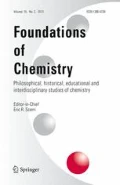REFERENCES
J.M. Blatt and V.F. Weisskopf. Theoretical Nuclear Physics. New York: Dover, 1979.
B. Friedrich and D. Herschbach. Space Quantization: Otto Stern's Lucky Star. Daedalus 127: 165–191, 1998.
H. Goldstein. Classical Mechanics. Reading: Addison-Wesley, 1980, pp. 70, 499.
G. Herzberg. Atomic Spectra and Atomic Structure. New York: Dover, 1944, p. 148.
E.A. Hinds. Physica Scripta T70: 34–41, 1997.
S. Kais and D.R. Herschbach. Journal of Chemical Physics 100: 4367–4372, 1994.
L.D. Landau and E.M. Lifshitz. Quantum Mechanics. Oxford: Pergamon Press, 1977.
K.R. Meyer. Periodic solutions of the N-Body Problem. Lecture Notes in Mathematics 1719. Berlin: Springer-Verlag, 1999.
W.H. Miller. Quantum and Semiclassical Theory of Chemical Reaction Rates. Faraday Discussions 110: 1–21, 1998.
J.D. Morgan and W. Kutzelnigg. Journal of Physical Chemistry 97: 2425–2434, 1993. <nt>The Hund rules state that (a) among many-electron states arising from the same configuration of spin-orbitals, the energy of the state decreases as the total spin S of the state increases; (b) among many-electron states of the same total spin arising from the same configuration, the energy of the state decreases as the total orbital angular momentum L increases; (c) If a shell is less (more) than half-full, then the energy of the state decreases (increases) with J. In this formulation, the rules apply to ground as well as excited states</nt>.
A. Pais. Niels Bohr's Times. Oxford: Clarendon Press, 1991.
L. Pauling. General chemistry. New York: Dover, 1970, p. 123. <nt>The letters originally stood for sharp, principal, diffuse, etc. whose meaning is hard to fathom today. Pauling hypothesized that the letters actually stand for “So Poorly Did Foolish Gelehrte Have It.” E. Scerri. Just How Ab Initio is Ab Initio Quantum Chemistry? Foundations of Chemistry, 2004, this issue. The presentation and paper given by Scerri in 2001 on which I am commenting was entitled “Has quantum mechanics explained the periodic table?”</nt>.
M. Weissbluth. Atoms and Molecules. New York: Academic Press, 1978.
Author information
Authors and Affiliations
Rights and permissions
About this article
Cite this article
Friedrich, B. ... hasn't it? A commentary on Eric Scerri's Paper ``Has Quantum Mechanics Explained the Periodic Table?'' . Foundations of Chemistry 6, 117–132 (2004). https://doi.org/10.1023/B:FOCH.0000020999.69326.89
Issue Date:
DOI: https://doi.org/10.1023/B:FOCH.0000020999.69326.89

